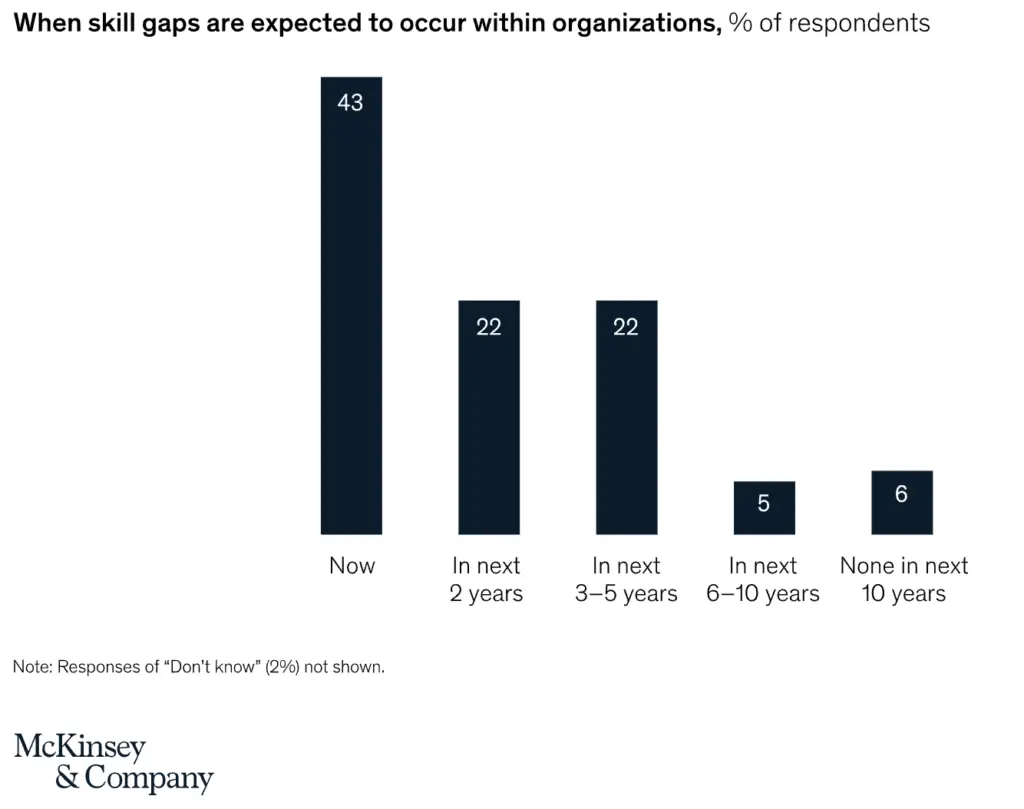A key principle in effective planning is to start with the end in mind. Whether designing a training program, setting business goals, or launching an employee development initiative, having a clear and measurable outcome from the outset increases the likelihood of success. This approach is especially important for mentoring programs, where well-defined objectives help drive meaningful impact.
We’ve found that the most successful mentoring programs within our client community leverage this idea. When successful admins are in the ideation process, they universally focus on having mentoring program objectives serving as a strong foundation and planning out how they will gather, measure, and respond to their data insights.
To help avoid situations where your mentoring programs aren’t aligned with your business needs, we recommend making sure your program objectives fit the following criteria:
- They’re aligned with a specific business need
- They’re measurable
- You know how to measure them
- They’ll provide you with data that you can actually use
This post is 100% focused on helping you with alignment. While every business is different, the following mentoring program objectives are what we’ve seen as the most common across companies we work with. If you’re trying to launch programs and get internal support, these are the most critical objectives that are most likely to help you gain executive buy-in for mentoring.
What Are Mentoring Program Objectives?
Mentoring program objectives are any measurable outcome you want to see from launching and running the program. Because an objective can simply be defined as “something you want to achieve,” by extension, the objective of a mentoring program will be “something you want to achieve through the use of a structured mentoring strategy.”
As simple as that is, you won’t be able to effectively determine what the objective should be unless you already have data to look at before starting.
When you launch mentoring programs, they should be aligned with specific business goals or objectives. But you should have data related to those goals or objectives that inform why a mentoring program can solve that area of need.
There’s a multi-step planning process you may want to use to root this out:
- Consult with your executive team or representatives from the C-suite: Meet with executive leaders for insights on current business challenges. Determine which of these are challenges that mentoring can address
- Data review: Analyze existing data to understand areas of concern highlighted by leadership.
- Strategic alignment: Align potential mentoring objectives with overall business strategy.
- Set priorities: Prioritize areas where mentoring can have the most impact in the shortest amount of time.
- Ask for and incorporate feedback: Use feedback from various stakeholders to refine objectives.
Mentoring program objectives should be data-driven from start to finish. That means analyzing your company data to determine where needs exist, aligning those needs with what mentoring programs can accomplish, and then planning around how mentoring can solve that problem and to what extent.
With that in mind, the most common mentoring program objectives we see across our clients focus on the following business needs:
- Employee retention
- Skill development
- Employee engagement
- Diversity, Equity, Inclusion, and Belonging (DEIB)
- Career development
Although companies may measure these concerns in different ways, most find they have significant needs in each area. Aligning your mentoring programs around one or more of these objectives will go a long way toward getting internal support, as long as you can show how your program will boost outcomes in these areas.
Objective 1: Increase Employee Retention
Here’s the good news: The Great Resignation is officially, at least in the United States. By the end of 2023, U.S. quit rates were back to their pre-pandemic numbers. The bad news: Employee turnover was already on an upward trend in 2019; all it’s done is return to that trend line.

It’s fitting, then, that we can drum up Gallup’s 2019 on the high cost of turnover, which it called a $1 trillion problem that year. Employee retention remains one of the biggest problems and largest headaches for companies. Tech industry layoffs and downsizing aside, many other industries are struggling to retain workers. Retention can cost between 0.5 to 2X an employee’s salary, depending on the industry, specialization, and job level.
Meanwhile, it can take months to replace employees who quit, leading to a loss of productivity that can significantly reduce revenue generation.
Here’s the kicker: Almost any mentoring program can help you lower turnover. The question is whether lowering turnover will be a primary or secondary objective for the program. Either way, you should highlight retention as an objective to your programs, and track data associated with turnover.
How do I incorporate employee retention into my program?
The best way to make sure your program impacts employee retention is by targeting the individuals or groups within your organization that have the highest turnover rates. You should work together with the HR team to examine retention data and exit survey data.
From there, your plan of attack will be to determine what types of programs these populations most need or want that will encourage them to stay at your company longer. At the same time, we’ve found that most mentoring programs have a net positive impact on employee retention, career development programs tend to be the most popular.
How do I use employee retention data to prove program success?
There are multiple strategies you can take to measure the impact of a mentoring program on employee retention:
- Examine the retention of mentoring program participants vs non-participants. This is a great strategy to use for voluntary programs where only a certain percentage of the target population is enrolled. (Quantitative)
- Examine the retention of the target group from before the program existed and then after the program’s first cycle has ended. This is a great strategy when your mentoring program is mandatory for the target population. (Quantitative)
- Comparison with Industry Averages: Compare your company’s retention rates against industry averages before and after implementing the mentoring program. (Quantitative)
- Collect feedback from both mentors and mentees about the program’s perceived impact on their decision to stay with the company. (Qualitative)\
Most of your data collection for this will be quantitative, which is great. Those are the hard numbers. But you also may want to get employee survey data in there to help match that to the participation data you’re seeing. For example, if mentoring program participants have a 50% higher retention rate than non-participants, but a feedback survey of participants shows only 2% citing the mentoring program as a reason for staying, there may be other factors at play that are actually impacting this objective.
Objective 2: Upskill Employees
The Great Resignation may be over, but that doesn’t mean companies have all the skilled labor they need to get the job done. In 2021, McKinsey found that 65% of companies expected to have a skills gap either right now or in the next 2 years. Another 22% reported they’d have a skills gap in the next 3-5 years from the time the survey was conducted.

How are they doing on that end? Not so great.
In its 2023 Future of Jobs report, the World Economic Forum found that companies reported just 41% of their employees bridged skills gaps with additional training. That’s down slightly from 2023. The organization also notes that “formulating effective reskilling and upskilling strategies for the next five years is essential for maximizing business performance.”
Even if your company has upskilled some of its workers, it likely hasn’t upskilled all of them. Its ability to be competitive in the market going forward is going to be dictated not by how well it can hire increasingly difficult-to-find high-skilled talent but by how well it helps existing employees upskill and learn on the job.
How do I incorporate upskilling into my program?
Mentoring and upskilling go hand-in-hand. You can easily make upskilling a key objective for your mentoring program when you design the program for that purpose. While upskilling can come naturally within other mentoring programs, you’re likely to get the best results when your program structure is focused on skill development.
Begin by doing the following:
- Conducting a detailed skills gap analysis
- Utilizing data from performance reviews, employee surveys, and industry trends
- Collaborate with HR and department heads to align the mentoring program needed skills
- Identify individuals within the company who possess those skills and the individuals who need those skills
- Design the mentoring program to include specific tracks or pathways focused on these key skills, ensuring a targeted and effective approach
Matching the skill-haves with the skill-nots is not always easy. However, when using mentor matching software, you can dramatically reduce the time, effort, and difficulty of answering these questions and making those pairs. All it takes is setting up your enrollment survey to focus on skills. Then, when you run the software to match participants, you can focus on pairing individuals based on these skill gaps.
But what happens when you have far more mentors than mentees? That’s going to be a common problem in any mentoring program, but especially one where you’re trying to upskill employees. The answer may be to focus on different mentoring formats, such as group mentoring or shorter-term flash mentoring/micro mentoring
How do I use upskilling data to prove program success?
There’s always a bit of angst around how to measure existing employee’s skills and knowledge quantitatively. While giving job candidates skills and knowledge tests is commonplace, this is far less common for existing employees. You could try to implement internal skills testing, but don’t be surprised if you face a lot of pushback, especially if employees are afraid that their skill gaps will be used against them.
Nevertheless, insightful ways exist to measure employee skill development without forcing them to take skills assessments. These can include:
- Having employees rate their level of familiarity with different skills with pre- and post-mentoring surveys. (Qualitative)
- Have managers rate their teams’ familiarity with different skills using pre- and post-mentoring surveys. (Qualitative)
- Measure productivity or output from employees pre- and post-mentoring. (Quantitative)
That last one is the more challenging of the three. After all, how does one measure productivity? Here are a few ways to go about that one:
- Measure output: Assess the quantity of work completed before and after the mentoring program. This could be the number of tasks completed, sales volume, or project deliverables. (Quantitative)
- Track efficiency: Look at the time taken to complete specific tasks or projects. An improvement in efficiency post-mentoring indicates enhanced skills. (Quantitative)
- Measure goal achievement: Monitor the achievement of individual and team goals related to specific skills or projects. (Quantitative)
- Measure output quality: Evaluate the quality of work through peer reviews, customer feedback, or error rates. Improved quality suggests better skills application. (Qualitative)
Sales mentorship programs are a great example of where a before and after can be seen very clearly. If mentoring program participants in a Sales Mentoring Program see an increase in landing deals after they’ve upskilled in the program, that’s a good sign that it’s working.
Objective 3: Support Career Development
Career development is intricately tied with retention and skill development, but it can be considered its own unique objective. Companies should focus on career development for several reasons, but this quote from an MIT Sloan article nicely sums up its importance:
“Sixty-seven percent of the individual contributors surveyed said they want to advance their career, but 49% said a lack of good career advice has hurt their job trajectory. Too often, executives ask employees to chart their own paths under the guise of empowerment, leaving them aimless.”
Particularly among U.S. workers, the desire for upward mobility at work is particularly strong. The fear of getting stuck in a “dead-end job” is also particularly strong, given its consistent appearance in popular culture, such as movies (like “Office Space”) and TV shows (particularly “The Office”).
How do I incorporate career development into my program?
Whereas employee retention is not likely to be the entire foundation of a mentoring program, and skill development likely would be, career development can go either way. Some programs may ultimately lead to career development by their very nature, especially when sponsorship results from the mentoring relationship. Conversely, companies may want to emphasize and formalize career development through dedicated mentoring programs.
Either approach can work, although the structured approach is likely to get more directly measurable results.
To make career development a key objective in your mentoring strategy, begin by:
- Mapping out clear career pathways within your organization
- Working closely with HR to understand various career trajectories and the skills needed for each
- Designing your mentoring program to align with these paths
- Matching mentees with mentors who have experience in desired career directions
Your matching strategy will come into play here again. When you make career development and career pathing questions part of the enrollment survey, you give yourself the flexibility to effectively match participants across various needs, including the type of career they want to pursue within your organization.
How do I use career development data to prove program success?
There are two clear ways to tie your mentoring programs to career development objectives:
- Promotion and internal movement data (participants vs non-participants). (Quantitative)
- Feedback surveys for promoted employees.
Track the career progression of mentees before and after the mentoring program. This can include promotions, transitions to new roles within the organization, and expanded job responsibilities. Additionally, conduct surveys to assess employees’ satisfaction with their career growth post-mentoring.
Measuring Success Beyond Promotions
While promotions are a clear indicator of career advancement, also consider the development of soft skills like leadership, communication, and strategic thinking. Surveys and 360-degree feedback can provide insights into these areas.
Successfully Meeting Objectives Requires the Right Tools
Mentoring produces incredible results, but only if you have the right tools. Trying to manually run programs is one of the common reasons we’ve seen that results in ineffective and poorly measurable results. When you take a software-based approach to aligning and measuring mentoring program objectives, all of the following are made possible:
- Easily scaled programs, allowing you to impact a larger population of employees
- Science-based matching, resulting in better quality matches and better program outcomes
- Automated data collection and analysis, ensuring you have all of the data you need right at your fingertips, without having to spend days or weeks trying to collect and parse it yourself
Think about how difficult launching, matching, and measuring the success of your mentoring programs would be if you were stuck in Excel spreadsheets. It’s a scary thought, to say the least. But that’s why some of the largest and most profitable and data-driven companies in the world, including Disney, T. Rowe Price, Hilton, Sony, and LinkedIn, have all turned to MentorcliQ to help them create more successful and more impactful mentoring programs.
See for yourself with a quick demo and be sure to sign up for an upcoming MentorCom event!




